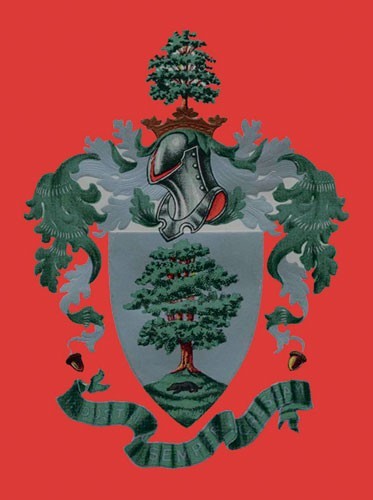
Schermerhorn coat of arms. (Frontispiece, Richard Schermerhorn Jr., Schermerhorn Genealogy and Family Chronicles, 1914.)

Schermerhorn’s original $300 mortgage to Morgan, dated May 27, 1809, as recorded by the Middlesex County Clerk’s Office, New Brunswick, New Jersey, and prominently witnessed by Judge Jacob Van Wickle’s daughters. Judge Van Wickle was a principal in the Old Bridge, New Jersey, pottery concern in the late eighteenth and early nineteenth centuries, and also owned land on the southwest end of Old Bridge, near Schermerhorn’s newly acquired property.

Hand-colored lithographed map, F. W. Beers and Co., 3, 1872. The pottery towns in the Middlesex County area (South Amboy, Old Bridge, Cheesequake, and Sayreville [Roundabout]) are shown here, along with the likely location of the pot house and land that John Schermerhorn bought an interest in from James Morgan Jr. in May 1809.

Detail, A Plan of the City of Richmond, Richard Young, 1809–1810. (Courtesy, Library of Virginia.) This plan shows the proximity of the DuVal and Schermerhorn stoneware manufactories to Rocketts Landing and the James River.
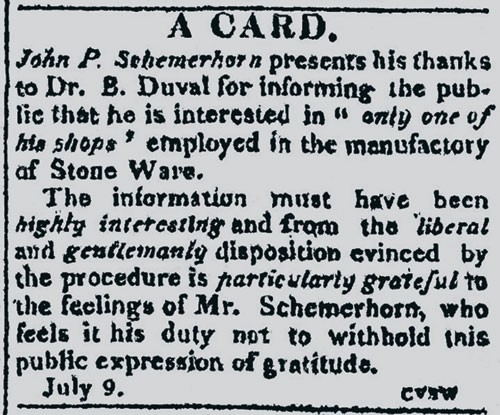
Notice, The Daily Compiler (Richmond), July 9, 1814. The sarcastic wording in this newspaper clipping reveals John P. Schermerhorn’s offended reaction to an advertisement placed by Benjamin DuVal that apparently affronted (and perhaps dishonored) him.
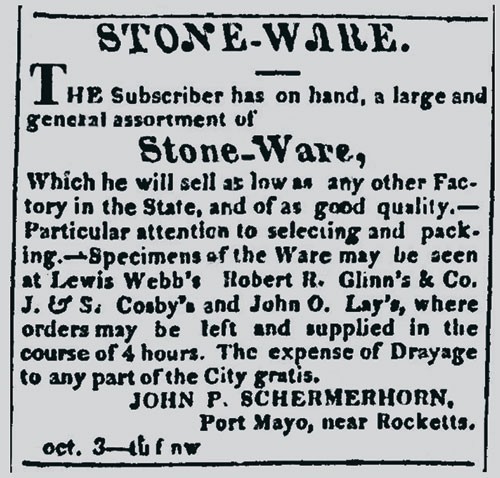
Advertisement placed by John P. Schermerhorn, Richmond Commercial Compiler, October 3, 1820, p. 3, col. 3.

Extended view of the J. P. Schermerhorn Stoneware Factory at Rocketts, as well as Montezuma, his nearby residence in Fairfield. The view is from a map made in the 1860s (George B. Davis et al., The Official Military Atlas of the Civil War [Avenel, N.J.: Gramercy Books, 1983], pl. XIX, no. 1) and shows the Fairfield vicinity of Henrico County where Schermerhorn built his home and its proximity to his James River factory at Rocketts.

Contemporary photograph of the Georgian revival edifice rebuilt in 1910 on the same site of John P. Schermerhorn’s Montezuma. (Photo, W. Sterling Schermerhorn.) The original structure followed the same plan as this house on the Mechanicsville Turnpike just northeast of Richmond.
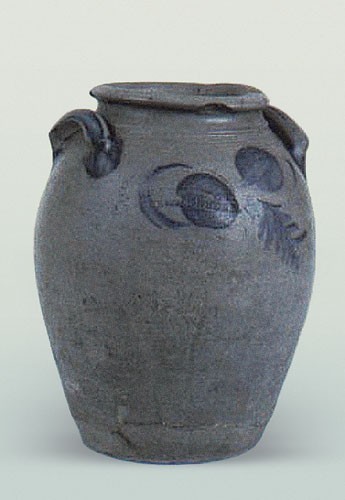
Storage jar, Schermerhorn Pottery, Richmond, Virginia, 1817–1850. Salt-glazed stoneware. H. 12". Capacity: 2 gallons. (Courtesy, Old Salem, Inc., Collection of the Museum of Early Southern Decorative Arts; photo, MESDA.) This ovoid storage jar, decorated with brushed-cobalt floral motifs involving horizontal vines interspersed with alternating round blossoms, is stamped with Schermerhorn’s maker’s mark, which includes a leaflike flourish.

Storage jar, Schermerhorn Pottery, Richmond, Virginia, 1817–1850. Salt-glazed stoneware. H. 17 1/2". Mark, below handles: “5.” Capacity: 5 gallons. (Private collection; unless otherwise noted, all photos by Gavin Ashworth.) This large, ovoid storage jar is stamped with a vivid maker’s mark and, with its brushed-cobalt floral motifs of horizontally flowing vines interspersed with round blossoms, is one of the most significant signed surviving vessels made by Schermerhorn.

Detail of the stamped maker’s mark with stamped cartouches on the vessel illustrated in fig. 9. (Old Salem, Inc., Collection of the Museum of Early Southern Decorative Arts; photo, MESDA.)
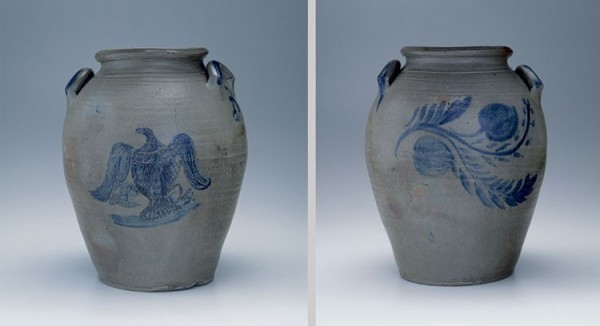
Storage jar, Schermerhorn Pottery, Richmond, Virginia, 1817–1837. Salt-glazed stoneware. H. 15". Capacity: 3 gallons. (Private collection.) This monumental storage jar displays the characteristic Schermerhorn rounded rim, well-defined collar/neck, and extruded crescent-shaped handles brushed with blue cobalt and placed high on the shoulder. Centered on one side is an incised federal-style eagle filled with blue cobalt. On the reverse are floral vines separating two rounded blossoms.
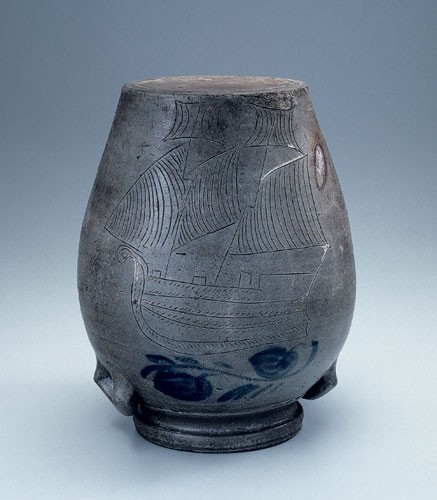
Storage jar, Schermerhorn Pottery, Richmond, Virginia, 1817–1837. Salt-glazed stoneware. H. 15". Capacity: 3 gallons. (Private collection.) Shown upside down, this ovoid storage jar is embellished with a blue floral vine, which connects leaves opposite opposing rounded flowers along the shoulder, as well as an inverted incised ship.

Storage jar, Schermerhorn Pottery, Richmond, Virginia, 1817–1837. Salt-glazed stoneware. H. 15 1/2". Capacity: 3 gallons. (Private collection.) The incised and cobalt-decorated long-legged bird on this ovoid storage jar appears to be nibbling on a cobalt flower with cobalt festoons above. The reverse is decorated with the most common motif used by Schermerhorn, opposing floral blossoms separated by flowing vines.
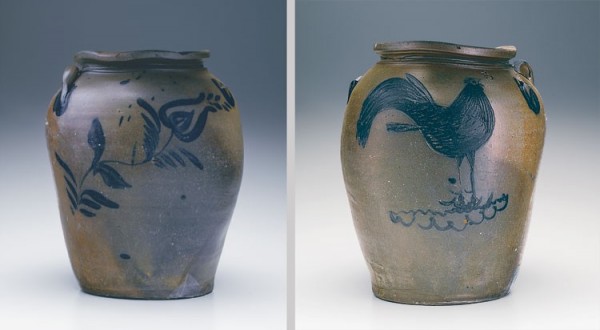
Storage jar, Schermerhorn Pottery, Richmond, Virginia, 1817–1837. Salt-glazed stoneware. H. 15". Mark, below rim: stamped “5.” Capacity: 5 gallons. (Private collection.) This ovoid vessel displays a well-defined incised and cobalt-filled rooster, or game cock, standing on horizontal cobalt festoons similar to those above the bird illustrated in fig. 14.
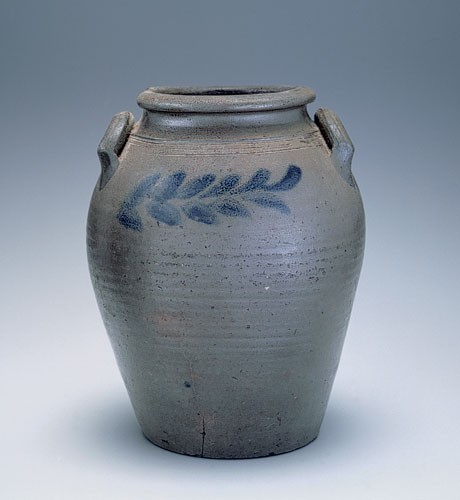
Storage jar, Schermerhorn Pottery, Richmond, Virginia, 1817–1850. Salt-glazed stoneware. H. 13 3/4". Capacity: 3 gallons. (Private collection.) A simple, brushed, blue-cobalt horizontal vine decorates both sides of this robust ovoid jar with pronounced neck, rounded rim, and highly placed extruded crescent-shaped handles.
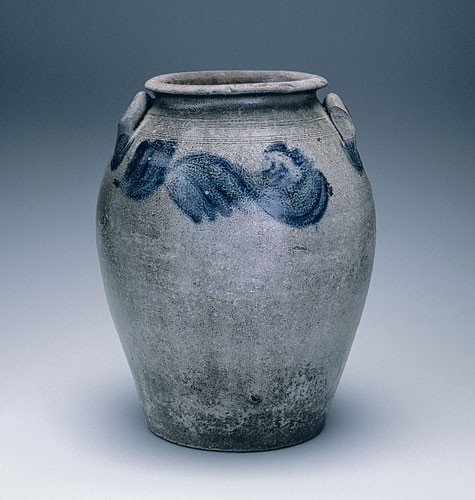
Storage jar, Schermerhorn Pottery, Richmond, Virginia, 1817–1850. Salt-glazed stoneware. H. 15 1/4". Capacity: 3 gallons. (Private collection.)
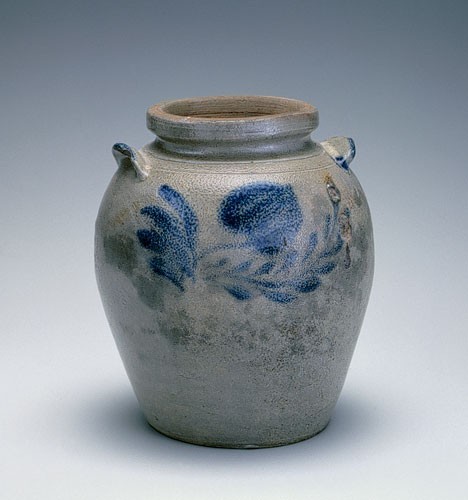
Storage jar, Schermerhorn Pottery, Richmond, Virginia, 1817–1850. Salt-glazed stoneware. H. 9 1/8". Capacity: 1 gallon. (Private collection.)
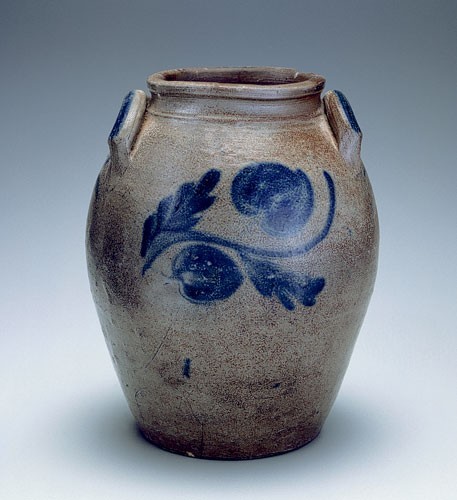
Storage jar, Schermerhorn Pottery, Richmond, Virginia, 1817–1837. Salt-glazed stoneware. H. 11 3/4". Capacity: 2 gallons. (Private collection.)
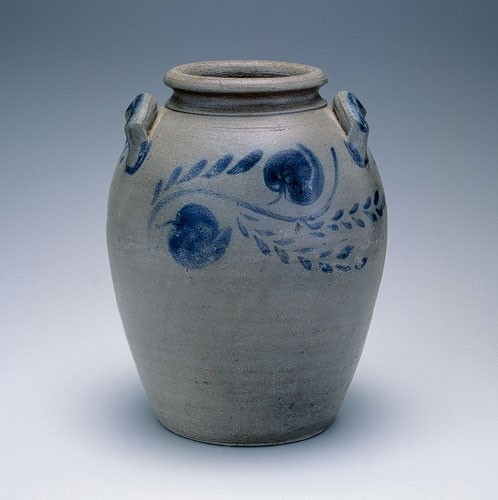
Storage jar, Schermerhorn Pottery, Richmond, Virginia, 1817–1837. Salt-glazed stoneware. H. 13". Capacity: 3 gallons. (Private collection.) An excellent example of Schermerhorn’s early Richmond production, this thick-walled, well-formed ovoid vessel has a pronounced rounded rim, highly placed crescent-shaped handles brushed with cobalt, and horizontal vines and two prominent round floral blossoms.
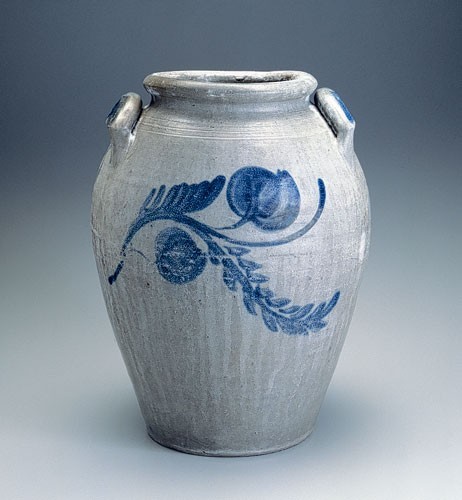
Storage jar, Schermerhorn Pottery, Richmond, Virginia, 1817–1837. Salt-glazed stoneware. H. 13 3/4". Mark, beneath each handle: “3.” (Private collection.)
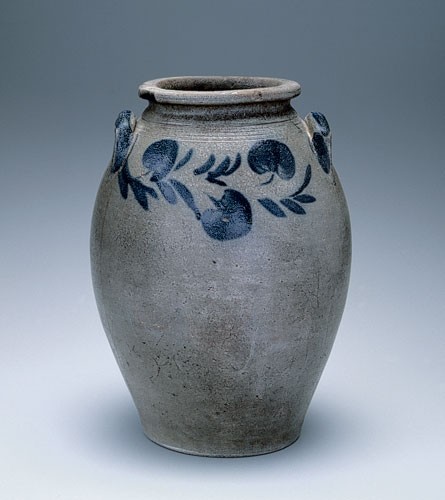
Storage jar, Schermerhorn Pottery, Richmond, Virginia, 1817–1837. Salt-glazed stoneware. H. 15 1/4". Capacity: 3 gallons. (Private collection.)
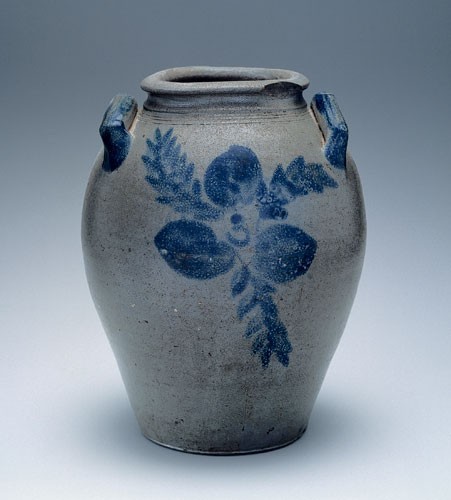
Storage jar, Schermerhorn Pottery, Richmond, Virginia, 1817–1837. Salt-glazed stoneware. H. 13 1/2". Capacity: 3 gallons. (Private collection.)

Storage jar, Schermerhorn Pottery, Richmond, Virginia, 1817–1837. Salt-glazed stoneware. H. 12". Capacity: 2 gallons. (Private collection.)

Storage jar, Schermerhorn Pottery, Richmond, Virginia, 1817–1837. Salt-glazed stoneware. H. 13 1/2". Capacity: 3 gallons. (Private collection; photo, Kurt C. Russ.) This ovoid stoneware vessel with its pronounced rounded rim and applied crescent handles exhibits a bold brushed-cobalt open-petaled flower oriented horizontally and extending from a large cluster of cobalt leaves. In underglaze cobalt lettering on its base is written “Shafter Edward Drinkard.”

Detail of the inscription on the base of the storage jar illustrated in fig. 25.
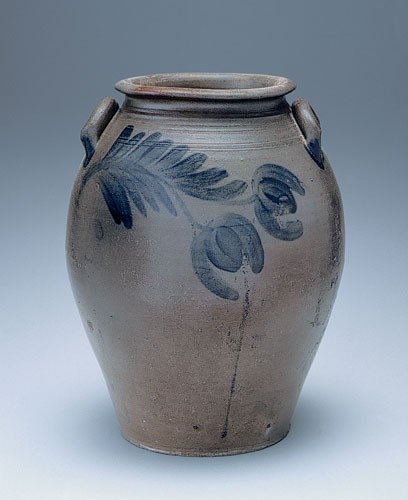
Storage jar, Schermerhorn Pottery, Richmond, Virginia, 1817–1837. Salt-glazed stoneware. H. 15 1/2". Capacity: 3 gallons. (Private collection.)

Storage jar, Schermerhorn Pottery, Richmond, Virginia, 1817–1837. Salt-glazed stoneware. H. 14 1/2". Capacity: 2 gallons. (Private collection.) This ovoid storage jar is decorated on one side with a brushed-cobalt profile of a man—perhaps a “man-in-the-moon”—and, on the other side, an underscored capacity mark (“2”).
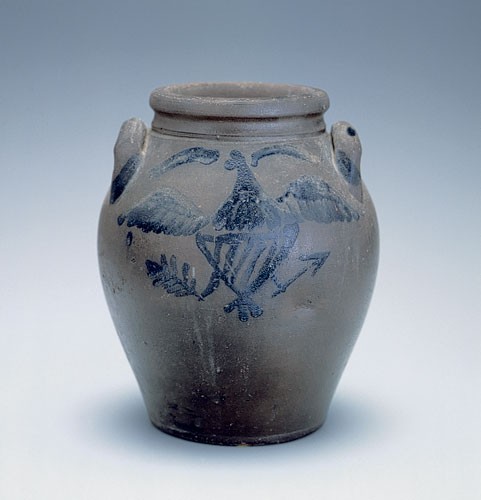
Storage jar, Schermerhorn Pottery, Richmond, Virginia, 1817–1837. Salt-glazed stoneware. H. 10". Capacity: 1 gallon. (Private collection.) Embellished on the front of this ovoid storage jar is a primitive cobalt slip–decorated eagle with extended wings, a shielded chest, and talons holding, respectively, an olive branch and an arrow. On the reverse is a similar eagle, with an olive branch in both talons.
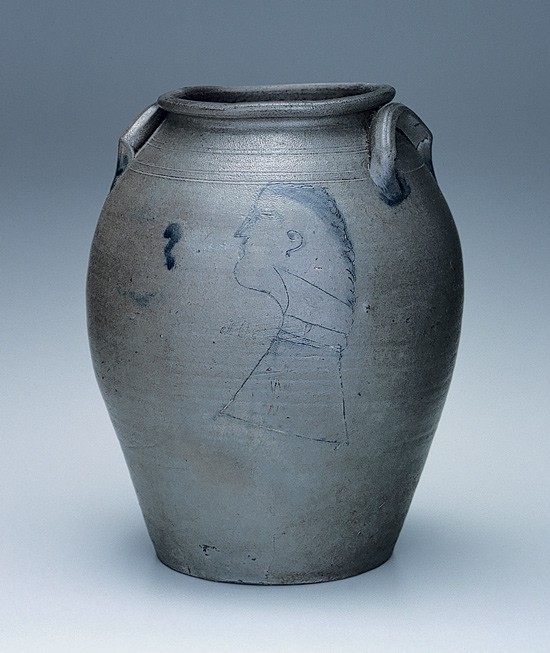
Storage jar, Schermerhorn Pottery, Richmond, Virginia, 1817–1837. Salt-glazed stoneware. H. 14 1/2". Capacity: 4 gallons. (Private collection.) On one side of this large, elongated vessel is a cobalt capacity mark—“4”—elaborately underscored with horizontal blue lines and squiggle mark. On the other side is an incised profile of a man highlighted with blue, and, incised across the figure’s collar, is “john p.” The image is presumed to be the signed self-portrait of the vessel’s maker, John P. Schermerhorn.
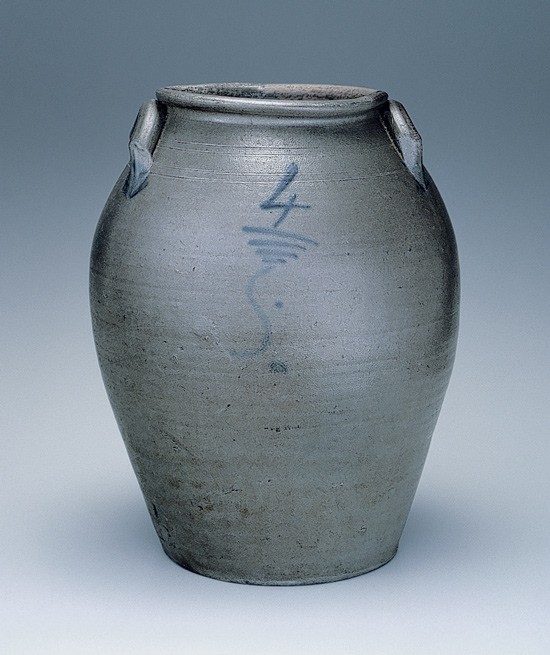
Storage jar, Schermerhorn Pottery, Richmond, Virginia, 1817–1837. Salt-glazed stoneware. H. 14 1/2". Capacity: 4 gallons. (Private collection.) On one side of this large, elongated vessel is a cobalt capacity mark—“4”—elaborately underscored with horizontal blue lines and squiggle mark. On the other side is an incised profile of a man highlighted with blue, and, incised across the figure’s collar, is “john p.” The image is presumed to be the signed self-portrait of the vessel’s maker, John P. Schermerhorn.
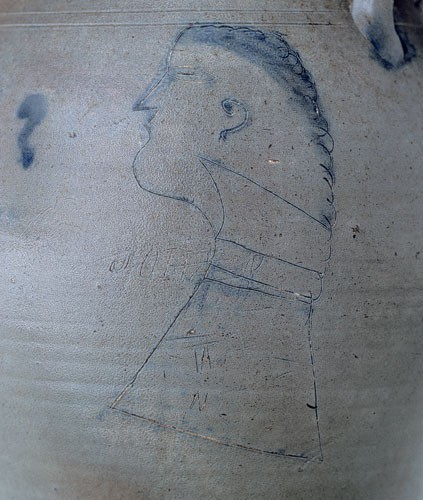
Detail of the incised profile depicted on the jar illustrated in fig. 30
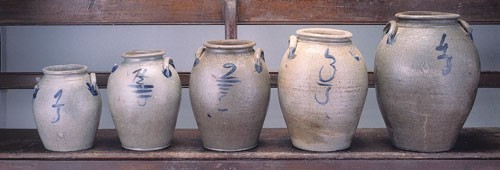
Storage jars, Schermerhorn Pottery, Richmond, Virginia, 1817–1837. Salt-glazed stoneware. From left to right: H. 9 1/2" (1 gallon), 11 1/2" (1 1/2 gallon), 12 1/2" (2 gallons), 13 3/4" (3 gallons), and 15" (4 gallons). (Private collection.) The squiggly cobalt mark found beneath the capacity mark in each of the vessels of this graduated series could represent a J or an S; hence, the potter’s signature is left to interpretation.
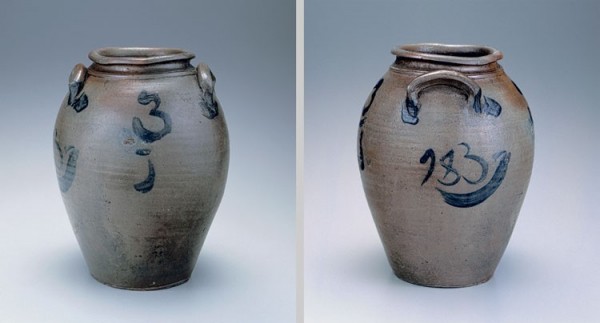
Storage jar, Schermerhorn Pottery, Richmond, Virginia, 1817–1837. Salt-glazed stoneware. H. 13 1/2". Capacity: 3 gallons. (Private collection.) A brushed cobalt date (“1837”) appears on the side of this vessel; on the reverse, a characteristic capacity mark (“3”) is underscored with a horizontal line and possibly a J, with blue highlights at the terminations of both extruded crescent-shaped handles and rounded rim. The date might refer to Schermerhorn’s last year of potting in Richmond. This piece was pictured in H. E. Comstock, Pottery of the Shenandoah Valley Region (Winston-Salem, N.C.: Museum of Early Southern Decorative Arts, 1994), p. 317, fig. 6.3, where it was incorrectly attributed to Rockbridge.

Storage jars, Schermerhorn Pottery, Richmond, Virginia, 1817–1837. Salt-glazed stoneware. H. 11 7/8" (2 gallons); 14" (3 gallons). (Private collection.) These two important stoneware jars show the heretofore undocumented association of the horizontally oriented brushed-cobalt floral spray with undulating vines interspersed with opposing or alternating floral blossoms with the brushed blue cobalt capacity designations underscored with horizontal lines and a squiggle suggestive of (depending on the crock) either a J or an S like the one on the reverse of the incised self-portrait crock.

Jug, Schermerhorn Pottery, Richmond, Virginia, 1817–1837. Salt-glazed stoneware. H. 16". Capacity: 3 gallons. (Private collection.)

Jug, Schermerhorn Pottery, Richmond, Virginia, 1817–1837. Salt-glazed stoneware. H. 17 1/2". Capacity: 4 gallons. (Private collection.)
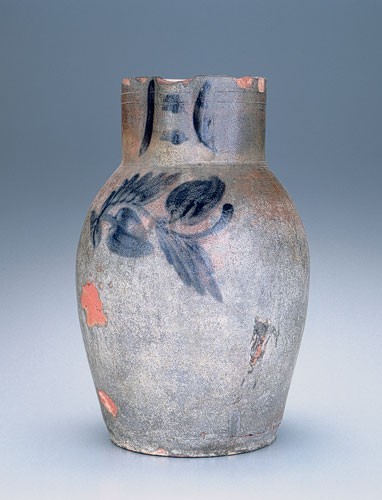
Pitcher, Schermerhorn Pottery, Richmond, Virginia, 1817–1837. Salt-glazed stoneware. H. 14 1/8". Capacity: 2 gallons. (Private collection.)
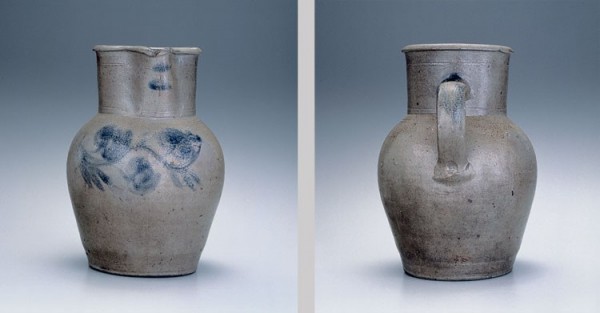
Pitcher, Schermerhorn Pottery, Richmond, Virginia, 1817–1837. Salt-glazed stoneware. H. 10 3/4". Capacity: 1 gallon. (Private collection.)
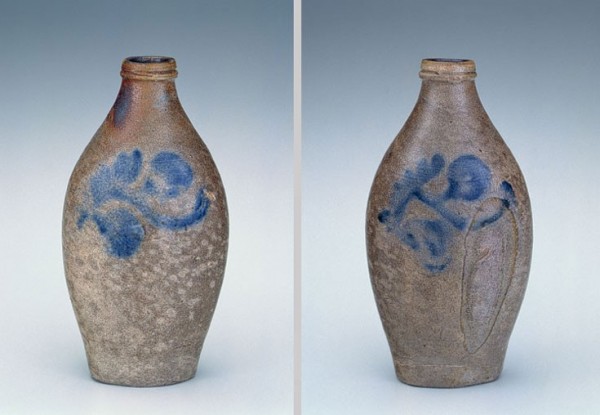
Flask, Schermerhorn Pottery, Richmond, Virginia, 1817–1837. Salt-glazed stoneware. H. 7 1/2". (Private collection.) This rather diminutive flask, with flattened sides decorated with brushed-cobalt floral vines separating opposing blossoms, has a distinctive incised ring on the lip and a concave bottom, resembling that of handmade glass bottles of the period.

Detail of the neck of the flask illustrated in fig. 39.

Detail of the concave bottom of the flask illustrated in fig. 39.
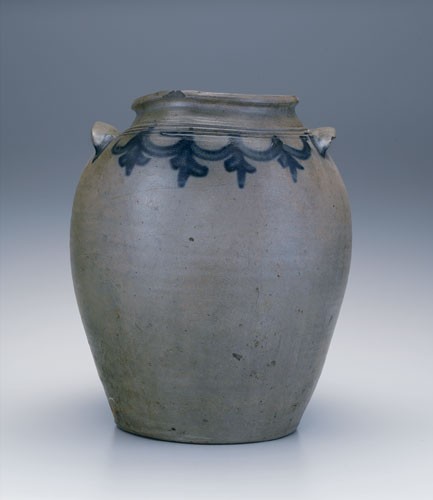
Storage jar, attributed to John P. Schermerhorn, Samuel Wilson, and/or associates, Richmond or Henrico County, Virginia, 1817–1850. Salt-glazed stoneware. H. 14 1/2". Capacity: 4 gallons. (Private collection.) This robust jar, with its diminutive, slightly rolled rim and concave neck, has on its front three incised concentric ridges at the shoulder, slightly curved earlike handles with cobalt at the ends, and brushed-cobalt loops (swags) and tassels along the shoulder. On the reverse are two simple tassels of four paired leaves. The rim resembles wares produced in Rockbridge County; the handles, however, resemble some Morgan-Wilson-related vessels from Staunton, Virginia.

Storage jar, attributed to John P. Schermerhorn, Samuel Wilson, and/or associates, Richmond or Henrico County, Virginia, 1817–1850. Salt-glazed stoneware. Capacity: 3 gallons. (Private collection.) This recently discovered vessel has the attributes of form and decoration that define Group 3. The important incised inscription on its base—“Richmond”—defines the area of manufacture.
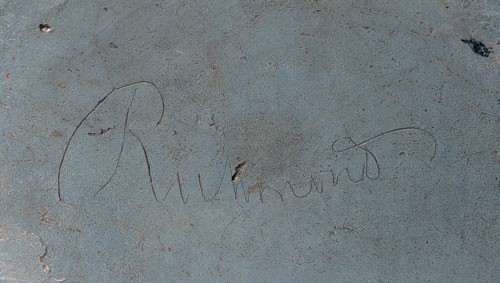
Detail of the inscription on the base of the jar illustrated in fig. 43.
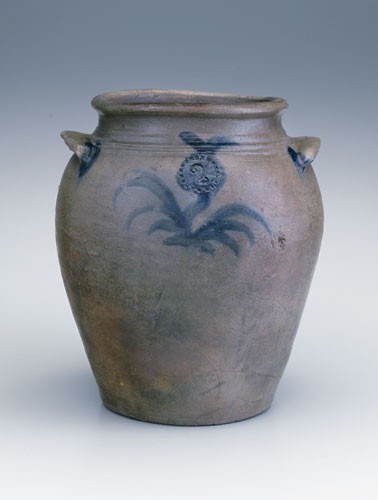
Storage jar, attributed to John P. Schermerhorn, Samuel Wilson, and/or associates, Richmond or Henrico County, Virginia, 1817–1850. Salt-glazed stoneware. H. 11 1/4". Capacity: 2 gallons. (Private collection; photo, Kurt C. Russ.) The bold, incised ridges at its shoulder, the slightly curved earlike handles with blue only at the terminals, and the impressed capacity stamp (“2”) encircled with teeth and incorporated into a blossom that extends upward from four opposing single-stroke brushed leaves resemble decorations on vessels illustrated in figs. 42 and 43.
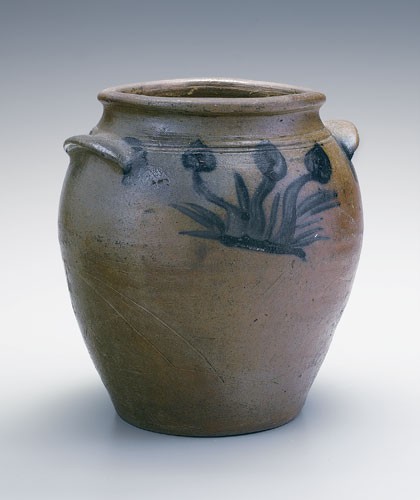
Storage jar, attributed to John P. Schermerhorn, Samuel Wilson, and/or associates, Richmond or Henrico County, Virginia, 1817–1850. Salt-glazed stoneware. H. 9". Capacity: approx. 1 gallon. (Private collection; photo, Kurt C. Russ.) On the concave of the reverse side of this storage jar are two or three deeply incised concentric lines intersecting with slightly curved, flaring earlike handles with blue at each end.
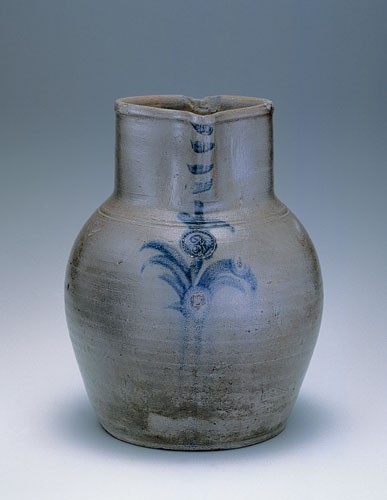
Pitcher, attributed to John P. Schermerhorn, Samuel Wilson, and/or associates, Richmond or Henrico County, Virginia, 1817–1850. Salt-glazed stoneware. H. 14 1/4". Capacity: 3 gallons. (Private collection.) The capacity stamp of this oversize pitcher is incorporated into a blossom with blue horizontal lines at the spout. The decoration as well as the stamp style are very similar to those on the storage jar illustrated in fig. 58.
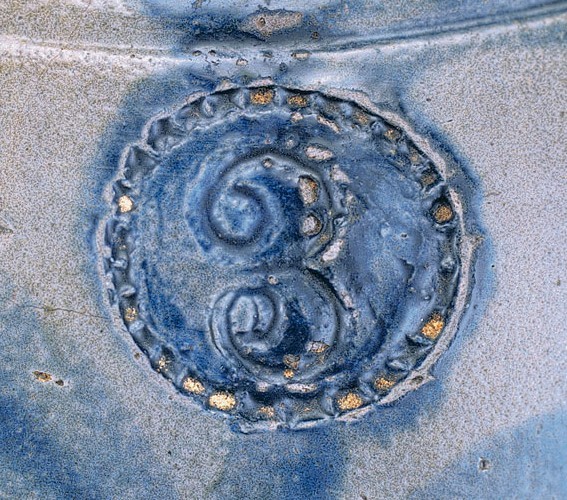
Detail of the capacity stamp on the pitcher illustrated in fig. 47.

Pitcher, attributed to John P. Schermerhorn, Samuel Wilson, and/or associates, Richmond or Henrico County, Virginia, 1817–1850. Salt-glazed stoneware. H. 14". Capacity: 3 gallons. (Private collection.)

Jug, attributed to John P. Schermerhorn, Samuel Wilson, and/or associates, Richmond or Henrico County, Virginia, 1817–1850. Salt-glazed stoneware. H. 12 1/4". Capacity: 1 1/2 gallons. (Private collection; photo, Kurt C. Russ.) The decoration on this jug features a simple brushed-cobalt circular wreath accented with four outwardly projecting tassels. Within the wreath is a brushed capacity mark (“1 1/2).

Jug, attributed to John P. Schermerhorn, Samuel Wilson, and/or associates, Richmond or Henrico County, Virginia, 1817–1850. Salt-glazed stoneware. H. 9 1/2". Capacity: approx. 1/2 gallon. (Private collection.) This jug was attributed to Rockbridge County in H. E. Comstock, Pottery of the Shenandoah Valley Region (Winston-Salem, N.C.: Museum of Early Southern Decorative Arts, 1994), p. 457, fig. 7.7. Its form is virtually identical to the jug illustrated in fig. 50, whereas its decoration is similar to that on the jar illustrated in fig. 64.

Jug, attributed to John P. Schermerhorn, Samuel Wilson, and/or associates, Richmond or Henrico County, Virginia, 1817–1850. Salt-glazed stoneware. H. 14 1/2". Capacity: 2 gallons. (Private collection.) The tassels decorating this jug are similar to those on the reverse of the jar illustrated in fig. 43.
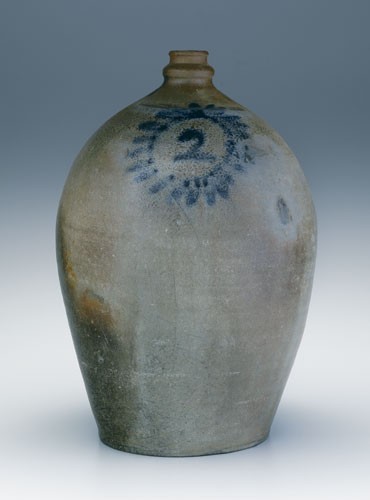
Jug, attributed to John P. Schermerhorn, Samuel Wilson, and/or associates, Richmond or Henrico County, Virginia, 1817-1850. Salt-glazed stoneware. H. 14 1/4". Capacity: 2 gallons. (Private collection; photo, Kurt C. Russ.) The cobalt wreath motif encloses the capacity mark (“2”) of this ovoid jug.

Jug, attributed to John P. Schermerhorn, Samuel Wilson, and/or associates, Richmond or Henrico County, Virginia, 1817–1850. Salt-glazed stoneware. H. 15 1/2". Capacity: 3 gallons. (Private collection; photo, Carole Wahler.) This ovoid jug is decorated with a primitive brushed-cobalt rabbit with upright ears.

Jug, attributed to John P. Schermerhorn, Samuel Wilson, and/or associates, Richmond or Henrico County, Virginia, 1817–1850. Salt-glazed stoneware. Capacity: 3 gallons. (Private collection; photo, Ralph Arthur.) Mirroring the form of the jug illustrated in fig. 54, this piece features a primitive brushed-cobalt owl; it is also pictured in Kurt C. Russ, “Exploring Western Virginia Potteries,” Journal of Early Southern Decorative Arts 21, no. 2 (1996): 115, fig. 10.
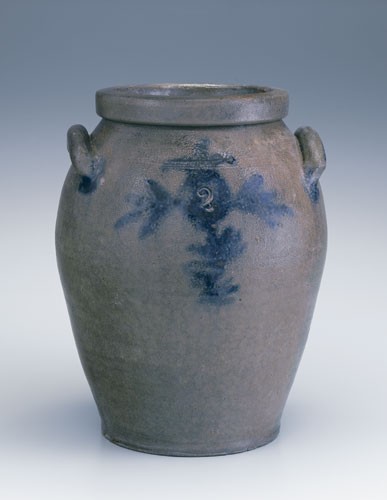
Storage jar, attributed to John P. Schermerhorn, Samuel Wilson, and/or associates, Richmond or Henrico County, Virginia, 1817–1850. Salt-glazed stoneware. H. 12 1/2". Capacity: 2 gallons. (Private collection.) The floral decoration relates to that on the jar illustrated in fig. 43. The stamped capacity mark (“2”) is identical to that illustrated in fig. 45 but without the encircling teeth.
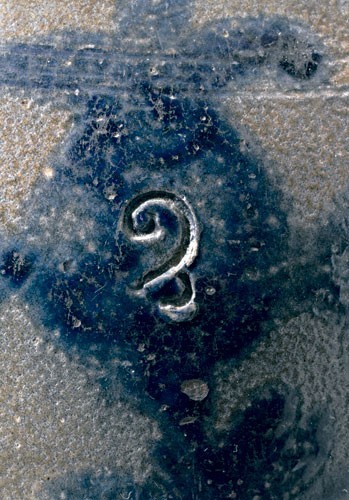
Detail of the capacity stamp of the jar illustrated in fig. 56.

Storage jar, attributed to John P. Schermerhorn, Samuel Wilson, and/or associates, Richmond or Henrico County, Virginia, 1817–1850. Salt-glazed stoneware. H. 14 1/2". Capacity: 3 gallons. (Private collection.) The form of this stoneware jar is typical of Schermerhorn—thick walls and a rounded rim, like those within the first group, embellished with the rather customary floral device (leafy vine with bloom)—yet on its reverse the brushed-cobalt wreathlike motif with tassels enclosing the capacity mark (“3”) is a decoration that specifically relates to the third group.
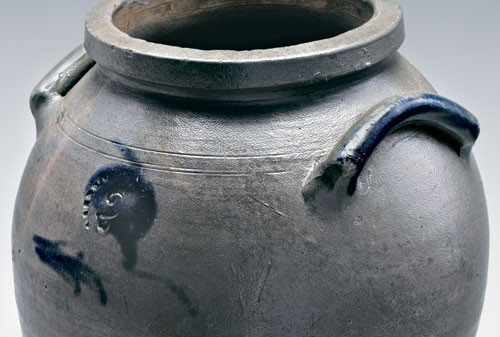
Storage jar, attributed to John P. Schermerhorn, Samuel Wilson, and/or associates, Richmond or Henrico County, Virginia, 1817–1850. Salt-glazed stoneware. H. 12 1/2". Mark: stamped “2” in dotted circle placed in center of brushed blue cobalt floral bloom. Capacity: 2 gallons. (Private collection.) The rolled applied handles of this jar are identical to those on the jar illustrated in fig. 56. The capacity mark is identical to those on the vessels illustrated in figs. 43, 45, and 47, suggesting that they are all from the same pottery.
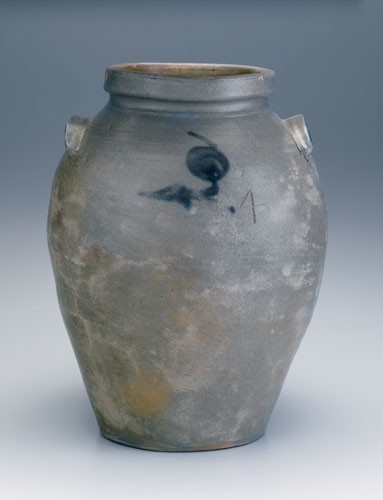
Storage jar, attributed to John P. Schermerhorn, Samuel Wilson, and/or associates, Richmond or Henrico County, Virginia, 1817–1850. Salt-glazed stoneware. H. 16 1/4". Mark: incised “4.” Capacity: 4 gallons. (Private collection.) This stoneware jar is very similar in form and decoration to the jar illustrated in fig. 59; its handles, however, are flattened, slightly curved with blunt ends, as those on the jar illustrated in fig. 45.
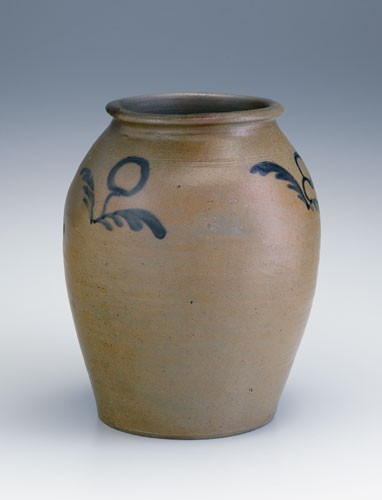
Storage jar, attributed to John P. Schermerhorn, Samuel Wilson, and/or associates, Richmond or Henrico County, Virginia, 1817–1850. Salt-glazed stoneware. H. 12". (Private collection.) The simple brushed-cobalt flower decoration—two opposing leaves supporting a stem with a circular open bloom—is similar to that on the jug illustrated in fig. 52.
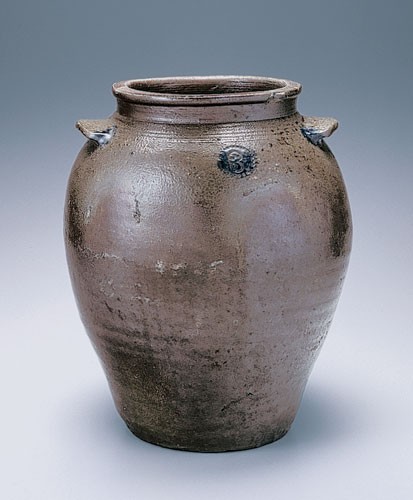
Storage jar, attributed to John P. Schermerhorn, Samuel Wilson, and/or associates, Richmond or Henrico County, Virginia, 1817–1850. Salt-glazed stoneware. H. 14". Mark: stamped “3” within a circular toothlike border. Capacity: 3 gallons. (Private collection.) Found in central Virginia, this ovoid stoneware jar has an elongated neck (1"+) resembling DuVal wares, a flat rim, three concentric incised lines at the collar, and slightly curved earlike handles with blunt ends resembling those from both Richmond and Rockbridge County.
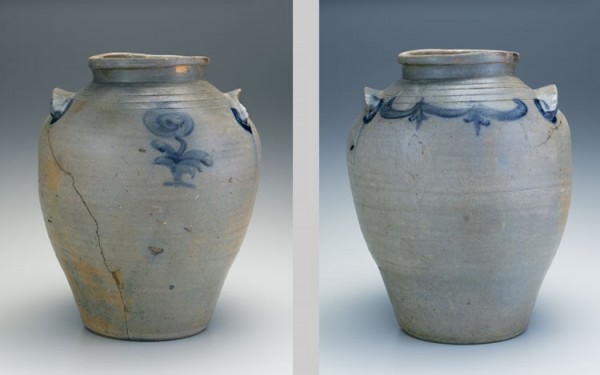
Storage jar, attributed to John P. Schermerhorn, Samuel Wilson, and/or associates, Richmond or Henrico County, Virginia, 1817–1850. Salt-glazed stoneware. H. 15 1/2". Capacity: approx. 4 gallons. (Private collection.) This vessel has a diminutive squared-off rim above a pronounced 3/4-inch collar similar to that illustrated in fig. 64. The cobalt swag-and-tassel decoration on the front resembles the decoration on the jar illustrated in fig. 42. On the reverse is a single floral motif with a “lollipop” bloom.
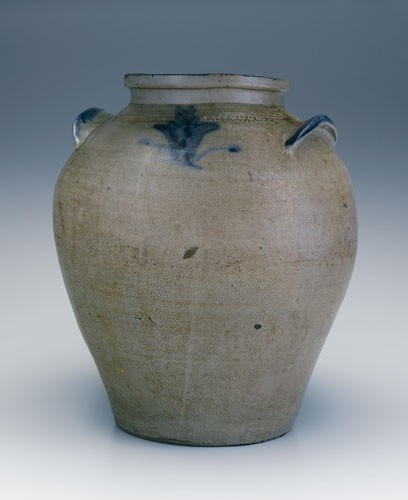
Storage jar, attributed to John P. Schermerhorn, Samuel Wilson, and/or associates, Richmond or Henrico County, Virginia, 1817–1850. Salt-glazed stoneware. H. 14 1/2". Capacity: 4 gallons. (Private collection.) The jar illustrated here has a diminutive squared-off rim above a pronounced 3/4-inch straight collar, impressed coggle wheel impressions at the shoulder, and slightly curved, flattened earlike handles with blunt ends accented with blue cobalt. The front is decorated with a simple multi-leaf floral motif, and on the reverse is a tassel.
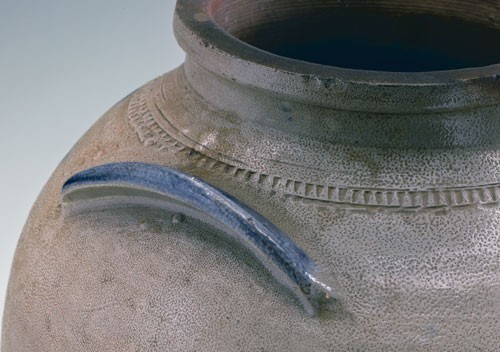
Detail of the handle and the impressed decoration of the jar illustrated in fig. 64.

Storage jar, attributed to John P. Schermerhorn, Samuel Wilson, and/or associates, Richmond or Henrico County, Virginia, 1817–1850. Salt-glazed stoneware. H. 13 3/4". Capacity: 3 gallons. (Private collection.) This vessel form is very similar to the piece illustrated in fig. 62.
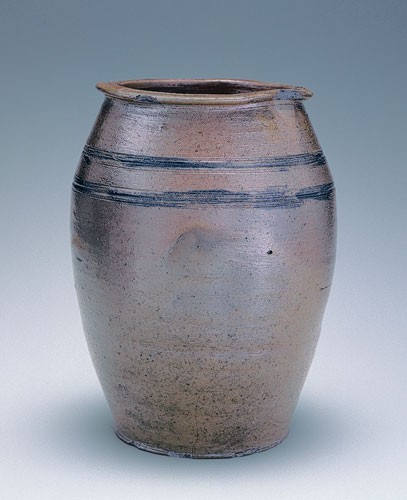
Jar, attributed to John P. Schermerhorn, Richmond, Virginia, 1811–1837. Salt-glazed stoneware. H. 11 3/4". Mark on base: stamped “.J.P:S:” (Private collection.)

Detail of the initials stamped on the base of the jar illustrated in fig. 67.

Photocopy of John P. Schermerhorn’s signature, taken from the 1820 Census of Manufacturers, Henrico County, Virginia.
